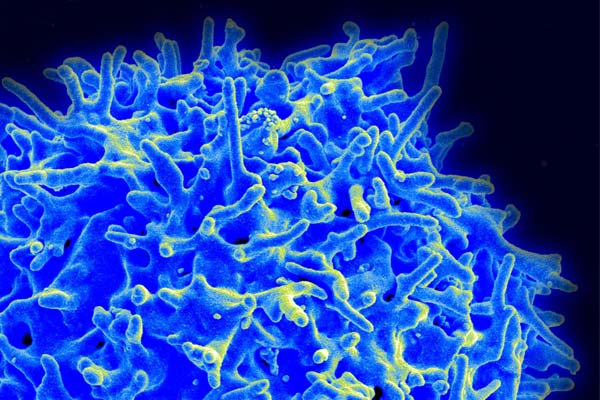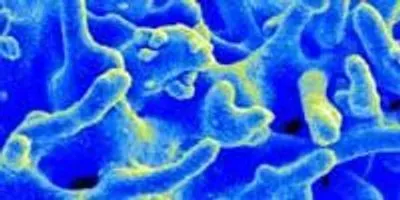 Researchers used artificial intelligence and robotic engineers to process cell data.Image credit: National Institute of Allergy and Infectious Diseases via FlickrProtein locations in a cell have been recorded in unprecedented detail as part of a ‘protein map’ developed by University of Toronto scientists.
Researchers used artificial intelligence and robotic engineers to process cell data.Image credit: National Institute of Allergy and Infectious Diseases via FlickrProtein locations in a cell have been recorded in unprecedented detail as part of a ‘protein map’ developed by University of Toronto scientists.
The new map allows researchers to look much more closely into what happens in a cell when disease strikes and will also help scientists determine better treatments.
“In this study, we looked at where proteins sit in the cell to find clues about their function,” said Jason Moffatt, an associate professor at U of T's Donnelly Centre and Canada Research Chair in Functional Genomics of Cancer.
Moffatt co-led the study, published in the journal Cell, with Donnelly Centre researchers Brenda Andrews and Charles Boone.
Proteins, which are products of genes, are responsible for all workings of a cell. Some move between compartments when they receive a signal from the outside world.
“That signal might be, ‘grow,’ ‘divide,’ ‘stop dividing.' In order to make that happen, proteins will move around, shift around their building blocks,” said Andrews.
“It's really important to understand how that happens if we're going to be able to understand why cells are healthy and why they're sometimes diseased.”
Much as the shipping or airline routes give insights into the state of world economy, so this new protein map will help scientists understand better what happens in cells when they are healthy and what goes wrong in a disease.
While cells do their jobs – such as making, maintaining and repairing our bodies – they continuously move proteins around. But scientists understand very little about how this traffic occurs inside our cells. This is about to change as the new map, which charts protein movement and abundance, becomes available.
The team developed the tool by building a state-of-the-art automated pipeline to monitor where proteins sit in the cell and to see how they move in response to genetic or environmental disruptions.
To visualize and count most of the roughly 6,000 proteins in the cell, researchers collected data for a mind-boggling 20 million cells. For more than a decade, the scientists worked closely together with robotic engineers, who built machines to handle the cells, and software writers who designed artificial intelligence-based algorithms to process the vast amount of data.
“The reason we need to do it on a large scale is because there simply are so many proteins,” says Andrews, who uses baker’s yeast as a model to understand human cell biology.
Yeast cells work in very similar ways to human cells but have fewer proteins, around a quarter the number that exist in more complex human cells. This relative simplicity has allowed researchers like Andrews and Boone to use yeast to make many fundamental insights into how both yeast and human cells work.
Their team not only charted protein movement and abundance in normal cells, but they also looked at what happens when cells carry a mutation, which could lead to a genetic disease, for example, or when they are exposed to different drugs.
“We’ve developed methods that allow scientists to examine all of proteins in the cell and how they change in response to any kind of perturbation,” said Andrews.
Next, the researchers will use this powerful pipeline to investigate how proteins move in human cells, such as cancer cells, to understand better the origin of the disease, but also to search for new treatments.
“We want to understand how all proteins are moving, at a systems level, in cancer cells upon, say, a treatment with a drug or genetic perturbation, so that we can identify vulnerabilities in cancer cells, in terms of protein localization and abundance, and start thinking about how to best target those changes,” said Moffatt.
A detailed database of protein locations will be made available this month through G3: Genes | Genomes | Genetics, the official journal of the Genetics Society of America, so that anyone can look up location and movement of their proteins of interest.
Protein locations in a cell have been recorded in unprecedented detail as part of a ‘protein map’ developed by University of Toronto scientists.
The new map allows researchers to look much more closely into what happens in a cell when disease strikes and will also help scientists determine better treatments.
“In this study, we looked at where proteins sit in the cell to find clues about their function,” said Jason Moffatt, an associate professor at U of T's Donnelly Centre and Canada Research Chair in Functional Genomics of Cancer.
Moffatt co-led the study, published in the journal Cell, with Donnelly Centre researchers Brenda Andrews and Charles Boone.
Proteins, which are products of genes, are responsible for all workings of a cell. Some move between compartments when they receive a signal from the outside world.
To continue reading this article, sign up for FREE to

Membership is FREE and provides you with instant access to eNewsletters, digital publications, article archives, and more.












